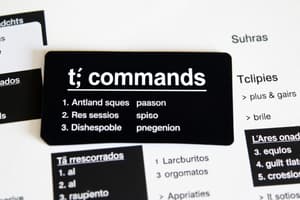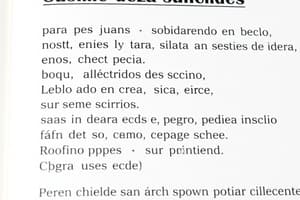Podcast
Questions and Answers
What do nosotros/as commands correspond to in English?
What do nosotros/as commands correspond to in English?
- We
- They
- You
- Let's (correct)
How is the negative nosotros/as command formed?
How is the negative nosotros/as command formed?
- Using the first-person plural form of the present subjunctive (correct)
- Using the infinitive form
- Using the affirmative command
- None of the above
What is the phrase for 'Let's cross the street' in Spanish?
What is the phrase for 'Let's cross the street' in Spanish?
Crucemos la calle.
How can 'Let's go' be expressed in Spanish?
How can 'Let's go' be expressed in Spanish?
What does 'No vayamos a la pescadería' express?
What does 'No vayamos a la pescadería' express?
Match the Spanish commands with their English translations:
Match the Spanish commands with their English translations:
Object pronouns are always placed in front of affirmative nosotros/as commands.
Object pronouns are always placed in front of affirmative nosotros/as commands.
What is the negative form of the nosotros/as command 'irse'?
What is the negative form of the nosotros/as command 'irse'?
Flashcards are hidden until you start studying
Study Notes
Nosotros/as Commands Overview
- Used to give orders or suggestions that include the speaker and others, akin to "Let's" in English.
- Affirmative and negative commands are formed using the first-person plural form of the present subjunctive.
Affirmative Commands
- "Let's + [verb]" can also be expressed as "vamos a + [infinitive]."
- The phrase "vamos a + [infinitive]" can mean both "let's" and "we are going to," depending on context.
Use of "Ir"
- "Let's go" is expressed with the present indicative form "vamos."
- Negative commands use the subjunctive: e.g., "No vayamos."
Pronoun Attachment Rules
- When "nos" or "se" is added to an affirmative command, the final "-s" from the verb is dropped.
- Examples include "Sentémonos" (Let’s sit) and "Démoselo" (Let’s give it to her).
Special Case: "Irse"
- The command form for "irse" (to go away) is "vámonos," with its negative form being "no nos vayamos."
- Object pronouns will attach to affirmative commands, requiring a written accent for stress preservation. Example: "Firmémoslo" (Let’s sign it).
Negative Command Structure
- Object pronouns are placed before negative commands, e.g., "No les paguemos el préstamo" (Let’s not pay them the loan).
Studying That Suits You
Use AI to generate personalized quizzes and flashcards to suit your learning preferences.




